|
|
|
|
|
Oil On
Canvas, Real Flavor of Old Masters
|
|

|
ARTWORKS
INDEX
A B C D E F G H I J K L M N O P Q R S T U V W X Y Z |
ARTISTS
INDEX
A B C D E F G H I J K L M N O P Q R S T U V W X Y Z |
|
|
| | |
|
|
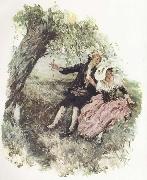 |
Arthur Ignatius Keller -- Click Here
|
|
American , 1866-1924
|
|
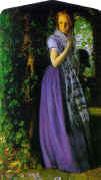 |
Arthur Hughes -- Click Here
|
|
1832-1915
British
Arthur Hughes Gallery
Hughes was born in London. His best-known paintings are April Love and The Long Engagement, both of which depict troubled couples contemplating the transience of love and beauty. They were inspired by John Everett Millais's earlier "couple" paintings but place far greater emphasis on the pathos of human inability to maintain the freshness of youthful feeling in comparison to the regenerative power of nature.
Like Millais, Hughes also painted an Ophelia and illustrated Keats's poem The Eve of St. Agnes. Hughes's version of the latter is in the form of a secular triptych, a technique he repeated for scenes from Shakespeare's As You Like It.
His works are noted for their magical, glowing colouring and delicate draughtsmanship.
Hughes was in close contact with the writer George MacDonald and illustrated some of his books as well as producing numerous illustrations for Norman MacLeod's monthly magazine, Good Words.
Hughes died in Kew Green, London, leaving about 700 known paintings and drawings, along with over 750 book illustrations. |
|
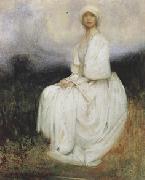 |
Arthur hacker,R.A. -- Click Here
|
|
1858-1919
was an English classicist painter. Born in London in 1858, Hacker was the son of Edward Hacker, a line engraver specialising in animal and sporting prints (who was also for many years the official Registrar of Births, Marriages and Deaths for Kentish Town in the St Pancras registration district, north London). In his art he was most known for painting religious scenes and portraits, and his art was also influenced by his extensive travels in Spain and North Africa. He studied at the Royal Academy between 1867 and 1880, and at the Atelier Bonnat in Paris. He was twice exhibited at the Royal Academy, in 1878 and 1910, and was elected an Academician in 1910. In 1894 he was the subject of a bust by Edward Onslow Ford. An original portrait by Hacker of Sir Alfred Keogh by hangs in the RAMC HQ Mess at Millbank, London. He died in London on November 12, 1919. In 1902, |
|
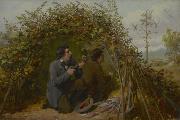 |
Arthur Fitzwilliam Tait -- Click Here
|
|
(February 5, 1819 -April 28, 1905) was an American artist who is known mostly for his paintings of wildlife. During most of his career, he was associated with the New York City art scene.
Tait was born in Lively Hall near Liverpool, England. At eight years old, because his father went bankrupt he was sent to live with relatives in Lancaster. It is during that time that he became attached to animals. Later on, in Manchester, England, Agnew & Zanetti Repository of Art acquired Arthur Tait who began self-learning to paint, as a twelve-year-old boy. |
|
|
|
|
|
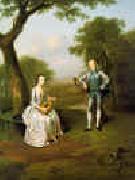 |
Arthur Devis -- Click Here
|
|
1712-1787
English
By 1728 he had left Preston, and the following year he was working in London for the Flemish topographical and sporting painter Peter Tillemans. There he specialized in landscape painting and copying various works in Tillemans studio after Marco Ricci, Giovanni Paolo Panini and Jan van Bloemen. Devis earliest known commission, Hoghton Towers from Duxon Hill, Lancashire (1735; priv. col., see 1983 exh. cat., no. 3), painted for Sir Henry Hoghton during a trip to Preston in 1734-5, shows Tillemans influence in its attention to detail and the use of thin, transparent paint. Thomas Lister with his Family (c. 1738; Chicago, IL, A. Inst.) demonstrates a similar interest in landscape, featuring the family group in Gisburn Park, Lancs. Devis had returned to London by 1742 and established himself as a painter of conversation pieces, with a studio in Great Queen Street. Roger Hesketh with his Family is typical of his work at this time; it shows how Devis transformed the intimacy of a Dutch 17th-century genre scene into an elegant interior with the group of sitters connected by formal, schematic gestures. Roger Hesketh stands apart, in a tastefully contrived pose, his legs crossed and right arm thrust inside his waistcoat. His son, Fleetwood, stands with his hand resting on a dog next to his wife, who is seated with an infant on her lap. The adjacent telescope, globe and marine paintings are intended to advertise Hesketh interest in astronomy and travel. |
|
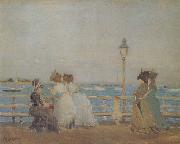 |
Arthur Clifton Goodwin -- Click Here
|
|
American Painter, ca.1864-1929 |
|
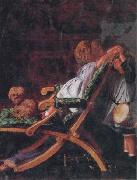 |
Arthur Boyd Houghton -- Click Here
|
|
English Painter and Illustrator , 1836-1875
His work was varied and was revered during the mid-19th century. He traveled to America and Russia, creating illustrations for The Graphic and for numerous books, including The Arabian Nights and Don Quixote. His work was strongly influenced by the Pre-Raphaelite Brotherhood. Paul Hogath wrote a biography, published in 1981 by Gordon Fraser Work by this artist is held within various public collections incluiding Tate Britain in London, as well as a number of private collections around the world. Houghton is best known for etchings but also produced a number of oil paintings, many of his wife and children. He also wrote a little poetry which was published in his lifetime. |
|
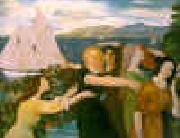 |
Arthur Bowen Davies -- Click Here
|
|
1862-1928
Arthur Bowen Davies Gallery
Arthur Bowen Davies (September 26, 1863 ?C October 24, 1928) was an avant-garde American artist.
He was born in Utica, New York and studied at the Chicago Academy of Design from 1879 to 1882. He briefly attended the Art Institute of Chicago and then moved to New York City where he studied at the Art Students League.
Davies was a principal organizer of the 1913 Armory Show and was a member of The Eight, a group of painters including five associated with the Ashcan school: William Glackens (1870-1938), Robert Henri (1865-1929), George Luks (1867-1933), Everett Shinn (1876-1953) and John French Sloan (1871-1951), along with Arthur B. Davies (1862-1928), Ernest Lawson (1873-1939) and Maurice Prendergast (1859-1924). Davies is best known for his ethereal figure paintings. He worked as a billboard painter, engineering draftsman, and magazine illustrator. |
|
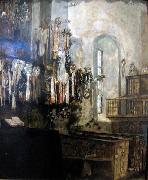 |
Arthur Ahnert -- Click Here
|
|
painted Interior of Wilhelmshausen church in 1898/1899.
|
|
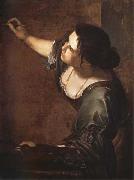 |
Artemisia gentileschi -- Click Here
|
|
1593-1652
was an Italian Early Baroque painter, today considered one of the most accomplished painters in the generation influenced by Caravaggio. In an era when women painters were not easily accepted by the artistic community, she was the first female painter to become a member of the Accademia di Arte del Disegno in Florence. She was one of the first female artists to paint historical and religious paintings, at a time when such heroic themes were considered beyond a woman's reach. Artemisia Gentileschi was born in Rome, July 8, 1593, the first child of the Tuscan painter Orazio Gentileschi, one of the best representatives of the school of Caravaggio. Artemisia was introduced to painting in her father's workshop, showing much more talent than her brothers, who worked alongside her. She learned drawing, how to mix color and how to paint. Since her father's style took inspiration from Caravaggio during that period, her style was just as heavily influenced in turn. But her approach to subject matter was different from her father's, as her paintings are highly naturalistic, where Orazio's are idealized. The first work of the young 17-year-old Artemisia (even if many at the time suspected that she was helped by her father) was the Susanna e i Vecchioni (Susanna and the Elders) (1610, Schönborn collection in Pommersfelden). The picture shows how Artemisia assimilated the realism of Caravaggio without being indifferent to the language of the Bologna school (which had Annibale Carracci among its major artists). It is one of the few Susanna paintings showing the two men planning their sexual harassment. It is likely that Artemisia had been sexually harrassed and painted Susanna as a reflection. In 1612, despite her early talent, Artemisia was denied access to the all-male professional academies for art. At the time, her father was working with Agostino Tassi to decorate the vaults of Casino della Rose inside the Pallavicini Rospigliosi Palace in Rome, so Orazio hired the painter to tutor his daughter privately. During this tutelage, Tassi raped Artemisia. Another man, Cosimo Quorlis had helped Tassi with the rape. After the initial rape, Artemisia continued to have sexual relations with Tassi, with the expectation that they were going to be married. However, Tassi reneged on his promise to marry Artemisia after he heard the rumor that she was having an affair with another man. Quorlis had threatened that if he could not have her, he would publicly humiliate her. Orazio pressed charges against Tassi only after he learned that Artemisia and Tassi were not going to be married. Orazio also claimed that Tassi stole a painting of Judith from the Gentileschi household. The major issue of this trial was the fact that Tassi had deflowered Artemisia. If Artemisia had not been a virgin before Tassi raped her, the Gentileschis would not be able to press charges. In the ensuing 7-month trial, it was discovered that Tassi had planned to murder his wife, had enjoined in adultery with his sister-in-law and planned to steal some of Orazio??s paintings. During the trial Artemisia was given a gynecological examination and was tortured using a device made of thongs wrapped around the fingers and tightened by degrees ?? a particularly cruel torture to a painter. Both procedures were used to corroborate the truth of her allegation, the torture device used due to the belief that if a person can tell the same story under torture as without it, the story must be true. At the end of the trial Tassi was imprisoned for one year. The trial has subsequently influenced the feminist view of Artemisia Gentileschi during the late 20th century. The painting Giuditta che decapita Oloferne (Judith beheading Holofernes) (1612 - 1613), displayed in the Capodimonte Museum of Naples, is impressive for the violence portrayed, and has been interpreted as a wish for psychological revenge for the violence Artemisia had suffered. One month after the trial, in order to restore her honor, Orazio arranged for his daughter to marry Pierantonio Stiattesi, a modest artist from Florence. Shortly afterwards the couple moved to Florence, where Artemisia received a commission for a painting at Casa Buonarroti and became a successful court painter, enjoying the patronage of the Medici family and Charles I. It has been proposed that during this period Artemisia also painted the Madonna col Bambino (The Virgin and Child), currently in the Spada Gallery, Rome. While in Florence, |
|
 |
Artemisia Gentileschi -- Click Here
|
|
Italian
1593-1652
Artemisia Gentileschi Gallery
Gentileschi was born on July 8, 1593 in Rome. She was the daughter of the painter Orazio Gentileschi and was trained by him. Our perception of Gentileschi has been colored by the legend surrounding her. Her alleged rape by her father colleague, the quadratura painter Agostino Tassi, when she was 17, was the subject of a protracted legal action brought by Orazio in 1611. Although she was subsequently married off to Pietro Antonio di Vicenzo Stiattesi in 1612 and gave birth to at least one daughter, she soon separated from her husband and led a strikingly independent life for a woman of her time - even if there is no firm evidence for the reputation she enjoyed in the 18th century as a sexual libertine. After her marriage, Gentileschi lived in Florence until about 1620. She then worked in Genoa and settled in Naples in 1630. Gentileschi traveled to England in 1638-40, where she collaborated with her father on a series of canvasses for the Queen House, Greenwich (now Marlborough House, London). Gentileschi died in Naples in 1652.
It is tempting to adduce the established biographical data in partial explanation of the context of her art: the sympathy and vigor with which she evokes her heroines and their predicaments, and her obsession with that tale of female triumph, Judith and Holofernes. But such possibilities should not distract attention from the high professional standards that Gentileschi brought to her art. In a letter, dated July 3, 1612, to the Grand Duchess of Tuscany, Orazio claimed that "Artemisia, having turned herself to the profession of painting, has in three years so reached the point that I can venture to say that today she has no peer. Despite the obvious exaggeration, one can agree that Gentileschi art was of a consistently high quality virtually from the beginning.
|
|
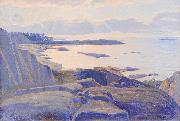 |
Aron Gerle -- Click Here
|
|
painted Skargardsmotiv in 1860-1930 |
|
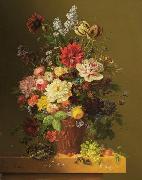 |
Arnoldus Bloemers -- Click Here
|
|
born at Amsterdam in 1792, painted flowers, fruit, and animals. He was instructed by Antonie Piera, but principally imitated Van Huijsum. He died at the Hague in 1844. The Rotterdam Gallery has a flower-piece by him.
|
|
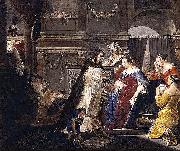 |
Arnold Houbraken -- Click Here
|
|
(28 March 1660 - 14 October 1719) was a Dutch painter and writer from Dordrecht, now remembered mainly as a biographer of artists from the Dutch Golden Age. He had ten children. His son Jacobus Houbraken (1698-1780) was an engraver of portraits and book illustrations, including books by his father. His daughter Antonina Houbraken also became an engraver for an Amsterdam publisher, and is known today for her embellishment of cityscapes and buildings with animals and people.
Houbraken was sent first to learn threadtwisting from Johannes de Haan, who introduced him to engraving. After two years he then studied art with Willem van Drielenburch, who he was with during the rampjaar, the year 1672. He then studied 9 months with Jacobus Leveck and finally, four years with Samuel van Hoogstraten. In 1685 he married Sara Sasbout, and around 1709 he moved from Dordrecht to Amsterdam. Arnold Houbraken painted mythological and religious paintings, portraits and landscapes. |
|
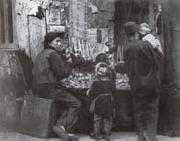 |
Arnold Genthe -- Click Here
|
|
German-born American Photographer, 1869-1942,German-born American photographer who received a doctorate in philology and linguistics from Jena University in 1894. As a photographer he was self-taught, and is probably best known for his pictures of Chinatown in San Francisco (1896-1906), where he opened a portrait studio in 1897, two years after arriving in America. Although his studio and equipment were destroyed in the 1906 earthquake, his prints survived and the Chinatown photographs were published in 1908. In that year he also started making autochromes. Genthe travelled widely in South America, Japan, and Germany, photographing landscapes and architecture, and in 1910 exhibited at the International Exhibition of Pictorial Photography in Buffalo organized by Alfred Stieglitz. Relocating to New York in 1911, he flourished as a celebrity portraitist. He also became celebrated for his dance photographs, published in The Book of Dance (1916) and Impressions of Isadora Duncan (1929). His autobiography, |
|
|
|
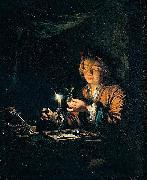 |
Arnold Boonen -- Click Here
|
|
Arnold van Boonen was a Dutch eminent portrait painter, was born at Dordrecht, in the Dutch Republic in 1669. He was first a scholar of Arnold Verbius, and was later instructed by Godefried Schalken. He painted genre pictures in the style of the latter, representing subjects by candlelight, but met with such encouragement in portrait painting that he devoted himself almost wholly to that branch of art. His style was well adapted to succeed in it. An excellent oolourist, a faithful designer of his model, and highly skilled, he was soon distinguished as one of the ablest artists of his day. He painted a great number of portraits of the most distinguished people of his time, among whom were Peter the Great, the Elector of Mentz, the Landgrave of Hesse-Darmstadt, the Prince and Princess of Orange, the great Duke of Marlborough, and several others. He painted some large pictures for the halls of the different companies at Amsterdam and Dordrecht. He died in 1729.
The Dresden Gallery has seven works by him, and the 'Woman Singing' in the Lille Gallery is also attributed to him. His son, Kasper van Boonen, also painted portraits, but in no way proved himself equal to his father.
|
|
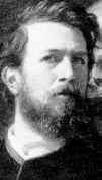 |
Arnold Bocklin -- Click Here
|
|
Swiss
1827-1901
Arnold Bocklin Locations
Arnold Bocklin was born on Oct. 16, 1827, in Basel. He attended the Dusseldorf Academy (1845-1847). At this time he painted scenes of the Swiss Alps, using light effects and dramatic views subjectively to project emotional moods into the landscape. In 1848 this romantic introspection gave way to plein air (open-air) objectivity after he was influenced by Camille Corot, Eugene Delacroix, and the painters of the Barbizon school while on a trip to Paris. But after the February and June revolutions Bocklin returned to Basel with a lasting hatred and disgust for contemporary France, and he resumed painting gloomy mountain scenes.
In 1850 Bocklin found his mecca in Rome, and immediately his paintings were flooded by the warm Italian sunlight. He populated the lush southern vegetation, the bright light of the Roman Campagna, and the ancient ruins with lonely shepherds, cavorting nymphs, and lusty centaurs. These mythological figures rather than the landscapes became Bocklins primary concern, and he used such themes as Pan Pursuing Syrinx (1857) to express the polarities of life: warm sunshine contrasts with cool, moist shade, and the brightness of womans spirituality contrasts with mans dark sensuality.
When Bocklin returned to Basel with his Italian wife, he completed the painting which brought him fame when the king of Bavaria purchased it in 1858: Pan among the Reeds, a depiction of the Greek phallic god with whom the artist identified. He taught at the Academy of Art in Weimar from 1860 to 1862, when he returned to Rome. Called to Basel in 1866, he painted the frescoes and modeled the grotesque masks for the facade of the Basel Museum.
Bocklin resided in Florence from 1874 until 1885, and this was his most active period. He continued to explore the male-female antithesis and painted religious scenes, allegories of Natures powers, and moody studies of mans fate. He ceased working with oils and began experimenting with tempera and other media to obtain a pictorial surface free of brushstrokes.
Bocklin spent the next 7 years mostly in Switzerland, with occasional trips to Italy; he devoted much of his energy to designing an airplane. Following a stroke in 1892, he returned to Italy, bought a villa in Fiesole, and died there on Jan. 16, 1901. Many of his late works depict nightmares of war, plague, and death. |
|
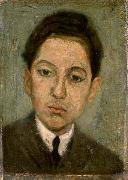 |
Armando de Basto -- Click Here
|
|
painted Retrato in 1910 |
|
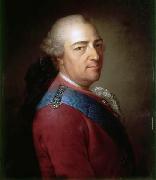 |
Armand-Vincent de Montpetit -- Click Here
|
|
painted Louis XV King of France and Navarre in 1774 |
|
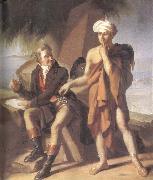 |
Armand-Philippe-Joseph Bera -- Click Here
|
|
1784-1836 |
|
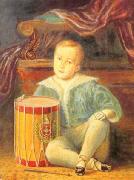 |
Armand Palliere -- Click Here
|
|
painted Pedro II of Brazil, aged 4 in 1830 |
|
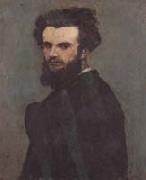 |
Armand guillaumin -- Click Here
|
|
French Impressionist Painter, 1841-1927
French painter and lithographer. He grew up in Moulins, but at 16 he returned to Paris to find work. Despite the opposition of his working-class family, he prepared for an artistic career while he supported himself in municipal jobs. He started drawing classes and then enrolled in the Academie Suisse, where he met Cezanne and Camille Pissarro. Guillaumin began his career as an avant-garde artist by exhibiting with them at the Salon des Refus's in 1863. |
|
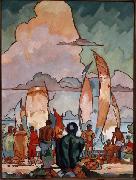 |
Arman Manookian -- Click Here
|
|
(1904 - 1931) was an Armenian-American painter. He was the oldest of three children born to a Christian Armenian family in Constantinople. As a teenager, he survived the Armenian Genocide. Manookian immigrated to the United States in 1920, at the age of 16, and studied illustration at the Rhode Island School of Design. He also took classes at the Art Students League of New York before enlisting in the United States Marine Corps in 1923. While serving in the U. S. Marine Corps he was assigned as a clerk to the author and historian, Major Edwin North McClellan. In 1925, McClellan and Manookian were transferred to Pearl Harbor. The latter supplied illustrations for Leatherneck Magazine and produced about 75 ink drawings for McClellanes history of the United States Marine Corps, which was never published. These drawings are now in the collection of the Honolulu Academy of Arts.
In 1927, Manookian was honorably discharged from the Marine Corps, but remained in Hawaii. He worked for the Honolulu Star-Bulletin and for Paradise of the Pacific.
His paintings are rare and highly valued due to his early death, by suicide, in 1931, and fewer than 30 are in existence. The Honolulu Academy of Arts held a memorial exhibition shortly after Manookianes death and a retrospective exhibition titled Meaning in Color/Expression in Line: Arman Manookianes Modernism Nov. 4, 2010 through April 24, 2011. The Bishop Museum and the Honolulu Academy of Arts are among the public collections holding works by Arman T. Manookian. According to the State of Hawaii's House of Representatives, he is "known as Hawaii's Van Gogh".
In early 2010 a group of seven Manookian paintings owned by the Hotel Hana-Maui were removed from public display. They were the only Manookian oil paintings known to be on public display anywhere in the world. Two of the murals, Red Sails and Hawaiian Boy and Girl, are now on long-term loan to the Honolulu Academy of Arts.
|
|
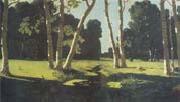 |
Arkhip Kuinji -- Click Here
|
|
was originally a Greek,Then he got to St. Petersburg1842 - 1910 |
|
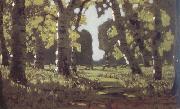 |
Arkhip Ivanovich Kuindzhi -- Click Here
|
|
Russian Painter, 1842-1910
Ukrainian painter, active in Russia. Initially self-taught as an artist, he twice failed the St Petersburg Academy's entrance examination, despite coaching by the marine painter Ivan Aivazovsky. In 1868, however, he was accepted as an external student. He persevered against conservative prejudice and poverty throughout his early career, supplementing his income by retouching photographs. In his early landscape paintings he often sought to capture seasonal moods, as in Autumn Mud (1872; St Petersburg, Rus. Mus.). A more human focus, however, is noticeable after 1874, when he joined the travelling exhibitions society the WANDERERS: the village houses dominate the landscape setting in Evening in Ukraine (1878; St Petersburg, Rus. Mus.). Kuindzhi's principal interest, however, was in lighting, and he obtained striking effects by using vivid colours, chiaroscuro contrasts and simple but cleverly conceived designs. Spectacular paintings, such as the Birch Grove (1879; Moscow, Tret'yakov Gal.), greatly moved contemporary viewers. Through years of experimentation, Kuindzhi developed a highly original technique, which he applied to an increasingly typical, at times almost visionary, treatment of subjects such as snow-covered mountains and moonlight (e.g. Elbnis: Moonlit Night, 1890-95; Moscow, Tret'yakov Gal.). Due to imperfections in the paints he used, many of his canvases soon darkened. |
|
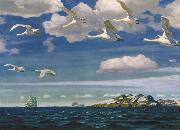 |
Arkady Rylov -- Click Here
|
|
(Russian: 29 January 1870 - June 22, 1939) was a Russian and Soviet Symbolist painter.
Rylov was born in the village Istobenskoye, Vyatka gubernia. He was brought in the family of his stepfather, a notary (Rylov's father had a psychiatric illness). He moved to Saint Petersburg and studied at the Technical Design School of Baron Schtiglitz (1888-1891), then at the Imperial Academy of Arts under Arkhip Kuindzhi (1894-1897).
Rylov was a member of the Mir iskusstva movement and its spin-off Union of Russian Artists also a member of the Association of Artists of the Revolutionary Russia. He was a chairman of the Kuindzhi Society.
He started as a historical painter (his graduation work in the Imperial Academy of Arts was Assault of Pechenegs on a Slav village but became a predominately landscape painter. Still many of his paintings have some allusions with Russian history.
Many of his landscapes painted after the October Revolution were seen as symbols of the revolutionary Freedom. At that time he also painted some typical Socialist Realism compositions like Lenin in Razliv. He taught in the Academy of Arts. In his studio he created almost a small nature reserve. There lived squirrels, rabbits, monkey Manka and many wild birds (without cages) and two anthills. According to Mikhail Nesterov wild animals and birds loved Rylov and often came to his studio.
|
|
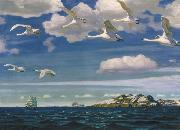 |
Arkady Alexandrovich Rylov -- Click Here
|
|
Arkady Alexandrovich Rylov (Russian, 29 January [O.S. 17 January] 1870 - June 22, 1939) was a Russian and Soviet Symbolist painter.
Biography
Rylov was born in the village Istobenskoye, Vyatka gubernia. He was brought in the family of his stepfather, a notary (Rylov's father had a psychiatric illness). He moved to Saint Petersburg and studied at the Technical Design School of Baron Schtiglitz (1888-1891), then at the Imperial Academy of Arts under Arkhip Kuindzhi (1894-1897).
In the Blue Expanse, 1918Rylov was a member of the Mir iskusstva movement and its spin-off Union of Russian Artists also a member of the Association of Artists of the Revolutionary Russia. He was a chairman of the Kuindzhi Society. |
|
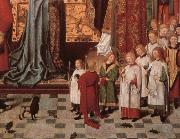 |
aristotle -- Click Here
|
|
Born: 384 B.C.
Birthplace: Stagira, Greece
Died: 322 B.C.
Best Known As: The author of Ethics |
|
 |
Arifi -- Click Here
|
|
The Sixteenth century Ottoman court poet
|
|
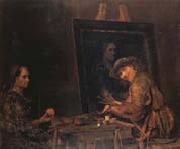 |
Arent De Gelder -- Click Here
|
|
1645-1727
was one of Rembrandt's last pupils while in Amsterdam, studying in his studio from 1661 to 1663. He was not only one of the most talented of Rembrandt's pupils, but also one of his most devoted followers, for he was the only Dutch artist to paint in the tradition of Rembrandt's late style into the 18th century. |
|
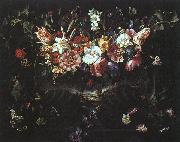 |
Arellano, Juan de -- Click Here
|
|
Spanish Baroque Era Painter, 1614-1676
Spanish painter. He was the pre-eminent painter of flower-pieces in 17th-century Spain. Although Spaniards of the previous generation had painted such works, it was the inspiration of Flemish and Italian examples in Madrid that from c. 1650 encouraged Arellano's success as a specialist in this genre. According to Palomino, who moved to the Court shortly after the artist's death and befriended many painters who had known him, Arellano began to paint flowers only in his thirties after a beginning that showed little promise. |
|
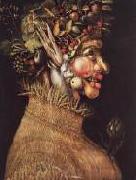 |
ARCIMBOLDO, Giuseppe -- Click Here
|
|
Italian Mannerist Painter, ca.1530-1593
Italian painter, draughtsman and tapestry designer, active also in Austria and Bohemia. He came from a distinguished Milanese family that included a number of archbishops of the city; his father was the painter Biagio Arcimboldo. Giuseppe is first documented in 1549, working with his father for Milan Cathedral; he received payments until 1558 for supplying paintings, designs for an altar baldacchino and stained-glass windows for the cathedral: the Story of Lot and the Life of St Catherine in the south transept windows are usually attributed to him. He collaborated with Giuseppe Meda in designing the gonfalone of St Ambrose in Milan, probably sometime soon after 1558. In 1556 he received a commission to paint the south wall and vault of the south transept of Monza Cathedral, also in Lombardy, a work that must have been completed by 1562. Portions of a fresco of the Tree of Jesse on the south wall there can be attributed to him. In 1558 he was paid for designing tapestries for Como Cathedral (in situ). On the basis of stylistic comparison with the windows in Milan and the frescoes in Monza, the design of a tapestry representing St John the Baptist Preaching and Baptizing (Monza, Mus. Duomo) can be attributed to Arcimboldo. The Archbishop of Milan, Carlo Borromeo, probably paid for this tapestry. |
|
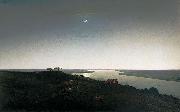 |
Archip Iwanowitsch Kuindshi -- Click Here
|
|
painted Nacht in ca. 1905e1908
|
|
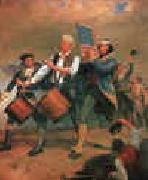 |
Archibald M Willard -- Click Here
|
|
1836-1918
Archibald M Willard Gallery |
|
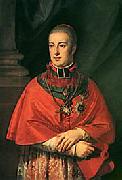 |
Archduke Rudolf of Austria -- Click Here
|
|
Rudolf Johannes Joseph Rainier von Habsburg-Lothringen, Archduke and Prince Imperial of Austria, Prince Royal of Hungary and Bohemia (8 January 1788 - 24 July 1831) was a Cardinal, an Archbishop of Olomouc, and a member of the House of Habsburg-Lorraine.
Born in Pisa, Italy, he was the youngest son of Emperor Leopold II and Maria Louisa of Spain. He was elected archbishop of Olomouc in 1819 and became cardinal in the year 1820.
In 1803 or 1804, Rudolf began taking lessons in piano and composition from Ludwig van Beethoven. The two became friends, and Rudolph became a supporter and patron of Beethoven; their meetings continued until 1824. Beethoven dedicated 14 compositions to Rudolph, including the Archduke Trio, the Hammerklavier Sonata, the Emperor Concerto and the Missa Solemnis. Rudolph, in turn, dedicated one of his own compositions to Beethoven. The letters Beethoven wrote to Rudolph are today kept at the Gesellschaft der Musikfreunde in Vienna.
On 24 March 1819 he was appointed, at the age of 31, Archbishop of Olomouc in the present day Czech Republic but then part of the Austrian Empire. He was made Cardinal-Priest of the titular church of S. Pietro in Montorio by Pope Pius VII on 4 June 1819. He was ordained a priest on 29 August 1819, and consecrated a bishop on 26 September.
In 1823 - 24, he was one of the 50 composers who composed a variation on a waltz by Anton Diabelli for Vaterländischer Kenstlerverein. In Rudolf's case, the music was published anonymously, as by "S.R.D" (standing for Serenissimus Rudolfus Dux).
|
|
|
|
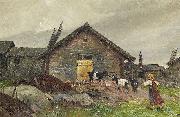 |
Arborelius -- Click Here
|
|
Olof Arborelius
Olof Arborelius 1842-1915
|
|
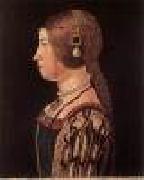 |
ARALDI, Alessandro -- Click Here
|
|
Italian Painter, ca.1460-1530
He apparently assisted with contemporary Cristoforo Caselli (il Temperello). His work shows the influences of early Venetian Renaissance painters such as Giovanni Bellini and Vivarini, but also Lorenzo Costa from Ferrara. He painted frescoes in the Benedictine monastery of San Paolo. He also painted two scenes with the story of St. Catherine, the Dispute before the emperor Maximilian and St. Catherine and St. Jerome, including an odd Annunciation (1514), for the abbess Giovanna da Piacenza (1514). Antonio Allegri (Correggio) would complete his own masterpiece frescoes for the abbess in a strikingly different, and for the age, more modern, style. |
|
|
|
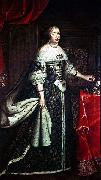 |
Apres Beaubrun -- Click Here
|
|
painted Anne d'Autriche en costume royal in ca. 1650 |
|
|
|
Apollonio di Giovanni -- Click Here
|
|
ca.1415-1465
Italian painter and illuminator. He was trained by illuminators in the circle of Bartolomeo di Fruosino and Battista di Biagio Sanguini (1393?C1451) and became a member of the Arte dei Medici e degli Speziali in 1442 and of the Compania di S Luca in 1443. Apollonio was influenced by Filippo Lippi, Lorenzo Ghiberti and Paolo Uccello. |
|
|
|
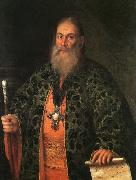 |
Antropov, Aleksei -- Click Here
|
|
Russian Painter, 1716-1795 |
|
|
|
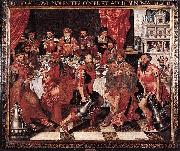 |
Antoon Claeissens -- Click Here
|
|
(his name is given in many varieties, with his first name rendered as Anton, Anthonie, Anthony, Anthuenis, and his surname as Claes, Claesz, Claeis, Claeiss, Claessens and Claeissins), the son of Pieter Claes the elder, painted historical and allegorical subjects, and portraits. He was a native of Bruges, and there entered the Guild of St. Luke in 1575, and became its dean in 1586, 1590, and 1601. He died in 1613. His works, several of which are in the Hôtel-de-Ville and churches of Bruges, are distinguished by their fine colouring and finish. In the H6tel-de-Ville is a 'Grand Banquet' with many portraits of magistrates of the time, dated 1574.
His son, Pieter Anthonie, was dean of the Guild of St. Luke at Bruges in 1607, and died in 1608.
|
|
|
|
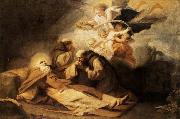 |
Antonio Viladomat y Manalt -- Click Here
|
|
Spanish, 1678-1755,Spanish Catalan painter. He was the most significant figure in Catalan painting from the end of the 17th century to the first half of the 18th. He trained with P. B. Savall and J. B. Perram?n in Barcelona. The arrival of the Archduke Charles (later Charles VI) of Austria in Barcelona in 1703 as a pretender to the throne during the War of the Spanish Succession (1702-13), accompanied by such Italian artists as Ferdinando Galli-Bibiena, acquainted Viladomat y Manalt with artistic trends in Italy. He experienced problems with the artists' guild in Barcelona because of his refusal to participate in the traditional work system. Despite this, his workshop-academy became a centre for the training of numerous painters, sculptors and engravers. Viladomat y Manalt was principally a religious painter, and his oil paintings include Christ Appearing to St Ignatius of Loyola (c. 1711-20; Barcelona, Jesuit Convent) and St Augustine and the Holy Family (Madrid, Prado). He also painted such murals as the tempera Angels with the Sudarium (c. 1727; Matare, S Mar?a, Capilla de los Dolores), but most of the others have disappeared. He painted an extensive series of monastic and evangelical works, in which his revival of compositions characteristic of the Spanish Golden Age is apparent. Examples include the Stigmatization of St Francis (c. 1724; Barcelona, Mus. A. Catalunya), part of a cycle of paintings on the life of St Francis commissioned for the cloister of the convent of S Francisco de As?s in Barcelona. His late Baroque style is related to the severe and realistic trend in Spanish painting in the early 17th century. Some interesting profane allegories by the artist are extant, notably the series Four Seasons (c. 1720-30; Barcelona, Mus. A. Catalunya), which consists of landscapes with genre scenes. Several of the still-lifes by Viladomat y Manalt such as the realistic Still-life with Dead Turkey (Barcelona, Mus. A. Catalunya), which has strong contrasts of light, bear an affinity with Neapolitan painting of the last decades of the 17th century. |
|
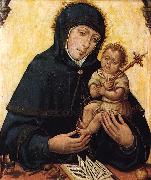 |
Antonio Vaz -- Click Here
|
|
painted A Virgem com o Menino in 1540 |
|
|
|
 |
Antonio Rotta -- Click Here
|
|
painted L'enfant avec les raisins in 1884 |
|
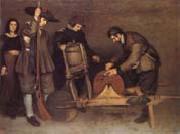 |
Antonio Puga -- Click Here
|
|
Spanish Baroque Era Painter, 1602-1648 |
|
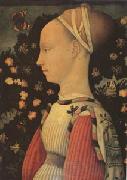 |
Antonio Puccio Called Pisanello -- Click Here
|
|
Verona before 1395-ca 1455 |
|
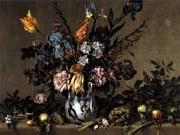 |
Antonio Ponce -- Click Here
|
|
Spanish, 1608-1662,Spanish painter. He had an undistinguished career in Madrid as a painter of still-lifes and flower-pieces. In 1624 Ponce was apprenticed to Juan van der Hamen y Leen, whose niece he married in 1628. The format of Ponce's compositions and some of his motifs derive from works by van der Hamen, though lacking their subtlety of composition, spatial clarity and formal conviction. In Vase of Flowers, signed and dated 1650 (Strasbourg, Mus. B.-A.), Ponce's style shows laboured imitation of van der Hamen's: his dry execution results in a paradoxically airless and petrified quality. Ponce was always a derivative artist, and some of his still-lifes with seasonal themes are similar to works by Francisco de Barrera, another modest painter with whom he was documented in the 1630s. Paintings from the 1640s and 1650s depicting baskets of fruit and bunches of grapes against light backgrounds are characterized by compositional informality, softer lighting and freer brushwork, through which Ponce attempted to convey the textures of objects and endow the subject with greater naturalness. |
|
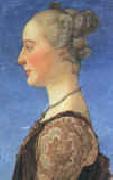 |
Antonio Pollaiuolo -- Click Here
|
|
1431-1498 Italian Antonio Pollaiuolo Galleries
Sculptor, painter, designer and engraver. He was trained as a goldsmith and bronze sculptor, probably in Lorenzo Ghiberti workshop. In 1466 he joined the Arte della Seta, the silkworkers guild (to which goldsmiths traditionally belonged), and he listed himself as a goldsmith and painter in the membership records of the Compagnia di S Luca in 1473; this is the only documented reference to him as a painter. In his tax return in 1480 he reported that he was renting a workshop specifically for goldsmiths work. He still described himself as a goldsmith, and not as a painter, in his last tax return in 1496. |
|
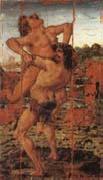 |
Antonio Pollaiolo -- Click Here
|
|
Italian Early Renaissance Painter and Sculptor, ca.1432-1498 |
|
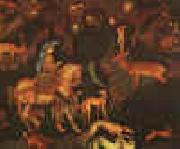 |
Antonio Pisanello -- Click Here
|
|
1395-1451 Italian Antonio Pisanello Galleries
professionally as Antonio di Puccio Pisano or Antonio di Puccio da Cereto, also erroneously called Vittore Pisano by Giorgio Vasari, was one of the most distinguished painters of the early Italian Renaissance and Quattrocento. He was acclaimed by poets such as Guarino da Verona and praised by humanists of his time who compared him to such illustrious names as Cimabue, Phidias and Praxiteles.
He is known for his resplendent frescoes in large murals, elegant portraits, small easel pictures, and many brilliant drawings. He is the most important commemorative portrait medallist in the first half of the 15th century.
He was employed by the Doge of Venice, the Pope in the Vatican and the courts of Verona, Ferrara, Mantua, Milan, Rimini, and by the King of Naples. He stood in high esteem of the Gonzaga and Este families.
He had many of his works wrongly ascribed to other artists such as Piero della Francesca, Albrecht Durer and Leonardo da Vinci, to name a few. While most of his paintings have perished, a good many of his drawings and medals have survived. |
|
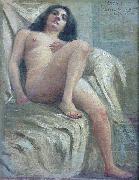 |
Antonio Parreiras -- Click Here
|
|
(1860 - 1937) was a Brazilian painter. Although much of his work was made up of historical and nude paintings, he expressed himself best in his landscapes, which combined European influences with those of his native Brazil.
In 1883, Parreiras met German painter George Grimm, who taught landscape, flora and wildlife painting, while studying at Brazil's Fine Arts Imperial Academy. Grimm influenced Parreiras to move away from academic traditions of painting in favor of the direct observation of nature, free brushstrokes and luminosity.
Parreiras traveled throughout Europe for a number of years, visiting many countries including Germany, Italy, and France, exhibiting his first female nude at the Salon in Paris in 1907. He continued to visit Europe after permanently returning to Brazil in 1914, and in 1929 received a gold medal in the Exposition International in Seville.
Parreiras also founded the Plein Air School in Niterei, Brazil, and a museum holding many of his works, the Museum Antônio Parreiras, is also in Niterei.
|
|
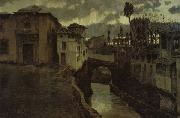 |
Antonio Munoz Degrain -- Click Here
|
|
Spanish , Valencia, 1840 - M - laga, 1924 |
|
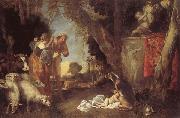 |
Antonio Maria Vassallo -- Click Here
|
|
Italian Baroque Era Painter, ca.1620-1670 |
|
 |
Antonio Maria Fabres y Costa -- Click Here
|
|
Spanish, 1854 - 1936
Antonio Fabres was a famous Spanish artist during the turn of the century. He was born in Barcelona Spain in 1854. It is said that he was the artist gene since his father was a draughtsman and his uncle a silversmith. He started studying at the Escuela de Bellas Artes in his native city at the age of 13. When he turned 21, he received a grant to study in Rome. There are records of his sculptures from early in his career but later on he became a painter almost exclusively. He joined Mariano Fortuny with a group that became known for their intense realism. Their popularity grew with the taste of the bourgeoisie seeking exotic images with oriental of medieval themes. He went back to Barcelona in 1886 and in 1894 he moved to Paris. The popularity he had earned during his decade in Italy helped him open a large studio where he could create complex scenes for the upper classes.
In 1902 the Academia de San Carlos decided to renovate their classical techniques with the ones of realism that were so popular in Europe at the time. Antonio Fabres was called to take the place of Santiago Rebull as head of this important institution. Although some of his students went on to become what was later known as the Post-Revolutionary Movement in Mexican art, the faculty had a hard time adapting to his distinct style and personality. In 1907, he returned to Rome. One of his last commissions in Mexico was the decorations of a hall at the Porfirio Diaz mansion where he mainly focused on art nouveau style .
Fabres was recognized most everywhere he traveled. He was acclaimed in Barcelona, London, Paris, Vienna and Lyon. At the end of his life he was dealt a very unfortunate blow when in 1926 he decided to donate a large amount of works to the Museo de Bellas Artes de Barcelona. In exchange for this generous donation he asked the Museum that a hall be built with his name, but the museum never built that hall and although he protested several times, they could never settle the argument. Antonio Fabres died in Rome in 1938.
|
|
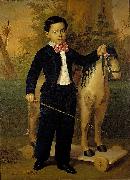 |
Antonio Maria Esquivel -- Click Here
|
|
Nacio en Sevilla en 1806. Comenzo los estudios de pintura en la Academia de Bellas Artes de Sevilla. Alli se familiarizo con la tecnica pictorica y el detallismo al estilo de Murillo.
En 1831, se traslado a Madrid, donde concurso en la Academia de San Fernando, siendo nombrado academico de merito. En contacto con el ambiente intectual madrileno de esos anos, participo activamente en la fundacion del Liceo Artistico y Literario en 1837, donde daria clases de Anatomia, asignatura que impartiria tambien mas tarde en la Academia de San Fernando.
En 1839, otra vez en Sevilla, sufrio una enfermedad que le dejo practicamente ciego; el artista, sumido en una profunda depresion, se intento suicidar arrojandose al rio Guadalquivir. Enterados sus companeros y amigos poetas y artistas y movilizados por el Liceo para ayudarle, sufragaron entre todos un caro tratamiento realizado por un prestigioso oftalmologo frances. Gracias a esto, en 1840 sano y recupero la vision. El artista, agradecido, pinto a sus amigos, poetas y pintores del Romanticismo, en un cuadro que se ha hecho justamente celebre. Como reconocimientos oficiales, recibo la placa del Sitio de Cadiz y la Cruz de Comendador de la Orden de Isabel la Catolica. En 1843 es nombrado Pintor de Camara y en 1847 academico de San Fernando, siendo ademas miembro fundador de la Sociedad Protectora de Bellas Artes. Como teorico de la pintura, redacto un Tratado de Anatomia Pictorica, cuyo original se guarda en el Museo del Prado. Fallecio en Madrid en 1857.
Sus hijos Carlos Maria (1830-1867) y Vicente tambien fueron pintores. |
|
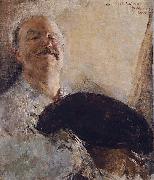 |
Antonio Mancini -- Click Here
|
|
(14 November 1852 - 28 December 1930) was an Italian painter.
Mancini was born in Rome and showed precocious ability as an artist. At the age of twelve, he was admitted to the Institute of Fine Arts in Naples, where he studied under Domenico Morelli (1823-1901), a painter of historical scenes who favored dramatic chiaroscuro and vigorous brushwork, and Filippo Palizzi (1818-1899), a landscape painter. Mancini developed quickly under their guidance, and in 1872, he exhibited two paintings at the Paris Salon.
Mancini worked at the forefront of Verismo movement, an indigenous Italian response to 19th-century Realist aesthetics. His usual subjects included children of the poor, juvenile circus performers, and musicians he observed in the streets of Naples. His portrait of a young acrobat in "Saltimbanco" (1877-78) exquisitely captures the fragility of the boy whose impoverished childhood is spent entertaining pedestrian crowds.
While in Paris in the 1870s, Mancini met Impressionists Edgar Degas and Édouard Manet. He became friends with John Singer Sargent, who famously pronounced him to be the greatest living painter. His mature works show a brightened palette with a striking impasto technique on canvas and a bold command of pastels on paper.
In 1881, Mancini suffered a disabling mental illness. He settled in Rome in 1883 for twenty years, then moved to Frascati where he lived until 1918. During this period of Mancini's life, he was often destitute and relied on the help of friends and art buyers to survive. After the First World War, his living situation stabilized and he achieved a new level of serenity in his work. Mancini died in Rome in 1930 and buried in the Basilica Santi Bonifacio e Alessio on the Aventine Hill.
His painting,The Poor Schoolboy, exhibited in the Salon of 1876, is in the Musee d'Orsay in Paris. Its realist subject matter and dark palette are typical of his early work. Paintings by Mancini also may be seen in major Italian museum collections, including Galleria Nazionale d'Arte Moderna e Contemporanea in Rome, and Museo Civico-Galleria d'Arte Moderna in Turin. The Philadelphia Art Museum holds fifteen oil paintings and three pastels by Mancini that were a gift of New York art dealer Vance N. Jordan. |
|
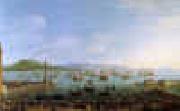 |
Antonio Joli -- Click Here
|
|
1700-1777
Italian
Antonio Joli Gallery
Born in Modena, he first apprenticed with Rafaello Rinaldi. He then worked in Rome with Panini and the Galli-Bibiena studio. He became a painter of stage sets for the theater in Modena and Perugia. By 1735, he had moved to Venice and stayed till 1746, when he traveled to Germany, London (1744-48), and Madrid (1750-54). In London, he decorated the Richmond mansion of the director of the King's Theater at Haymarket, John James Heidegger. He returned to Venice in 1754, where he became on of the founding members of the Accademia di Belle Arti di Venezia. He traveled to Naples in 1762, and stayed there until he died.
|
|
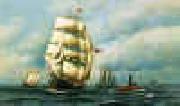 |
Antonio Jacobsen -- Click Here
|
|
1850-1921 Danish
(Resident in US)
was a maritime artist born in Copenhagen, Denmark, known as the "Audubon of Steam Vessels". Jacobsen painted over 6,000 portraits of sail and steam vessels, making him "the most prolific of marine artists". Many of his commissions came from sea captains, and Jacobsen was chosen both for the accuracy of his work and the low fees he commanded.
Jacobsen attended the Royal Academy of Design before heading across the Atlantic Ocean. He came to the United States in 1871, and settled in West Hoboken, New Jersey (now Union City, New Jersey), across the Hudson River from Manhattan and New York Harbor, its port filled with ships from America and around the world. Jacobsen got his start painting pictures of ships on safes, and as his reputation grew, he was asked to do portraits of ships by their owners, captains and crew members, with many of his works sold for five dollars.
|
|
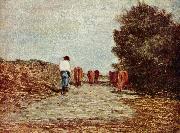 |
Antonio Fontanesi -- Click Here
|
|
23 February 1818 - 17 April 1882) was an Italian painter who lived in Meiji period Japan between 1876 and 1878. He introduced European oil painting techniques to Japan, and exerted a significant role in the development of modern Japanese yega (Western style) painting. He is known for his works in the romantic style of the French Barbizon school.
Fontanesi was born in Reggio Emilia, Emilia-Romagna, and trained with the landscape painters Prospero Minghetti and Vincenzo Carnevali. From 1841 to 1846 he made theatre sets and began painting landscapes. In 1850, he moved to Geneva, where he stayed until 1865. His main area of interest was landscape painting, which he expanded on after visiting the 1855 Exposition Universelle in Paris. He participated in important artistic exhibitions, displaying his works in Lyon, Turin, Milan, Florence, Genoa and the Triennial Exhibition of Fine Art in Bologna. He was nominated professor at the Academy of Lucca, but moved to Turin when a chair as a landscape professor was created specially for him at the Accademia Albertina in Turin from 1869 to 1876.
|
|
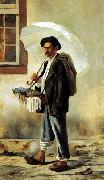 |
Antonio Firmino Monteiro -- Click Here
|
|
painted Matches in 1884 |
|
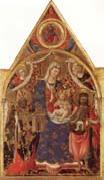 |
Antonio Fiorentino -- Click Here
|
|
Italian, 14th Century |
|
|
|
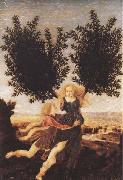 |
Antonio del Pollaiuolo -- Click Here
|
|
b.
1431/32, Firenze, d. 1498, Roma |
|
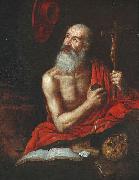 |
Antonio de Puga -- Click Here
|
|
painted San Jeronimo in 1636 |
|
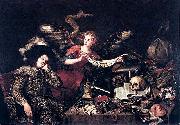 |
Antonio de Pereda -- Click Here
|
|
(ca. 1611-1678) was a Spanish Baroque-era painter , best known for his still lifes. Pereda was born in Valladolid. He was the eldest of three brothers from an artistic family. His father, mother and two brothers were all painters. He was educated in Madrid by Pedro de las Cuevas and was taken under the protective wing of the influential Giovanni Battista Crescenzi.After Crescenzi's death in 1635, Pereda was expelled from the court and began to take commissions from religious institutions. As well as still lifes and religious paintings, Pereda was known for his historical paintings such as the Relief of Genoa (1635) which was painted for the Buen Retiro Palace in Madrid as part of the same series as Velezquez's Surrender of Breda.
|
|
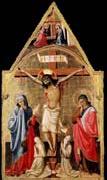 |
Antonio da Firenze -- Click Here
|
|
Italian Early Renaissance Painter, ca.1445-1510 |
|
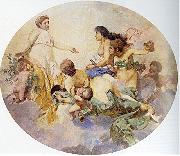 |
Antonio Cortina Farinos -- Click Here
|
|
February 16, 1841, Almassera, Valencia - November 6, 1890) was a Spanish artist. |
|
 |
Antonio Ciseri -- Click Here
|
|
(October 25, 1821 ?C March 8, 1891) was a Swiss painter of religious subjects.
Ciseri was born in Ronco sopra Ascona in the canton of Ticino in Switzerland. In 1833 he moved with his father to Florence. He was admitted in 1834 to the Accademia di Belle Arti, where he trained under Niccola Benvenuti. In 1849, he began offering instruction to young painters, and eventually ran a private art school. Among his earliest students was Silvestro Lega.[1]
Ciseri's religious paintings are Raphaelesque in their compositional outlines and their polished surfaces, but are nearly photographic in effect. He fulfilled many important commissions from churches in Italy and Switzerland. Ciseri also painted a significant number of portraits. He died in Florence on March 8, 1891.
|
|
|
|
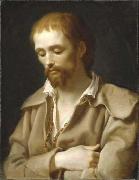 |
Antonio Cavallucci -- Click Here
|
|
(21 August 1752 - 18 November 1795) was an Italian painter of the late Baroque.
Cavallucci was born in Sermoneta in the Lazio. His artistic talents were recognized in an early stage by Francesco Caetani, Duke of Sermoneta in 1738-1810. In 1765, he brought the 13 year old Cavallucci to Rome, where he became a pupil of Stefano Pozzi and three years later of Gaetano Lapis. He also studied drawing at the Accademia di San Luca (c. 1769-1771).
His earliest work dates from the mid-1760s. It is a tempera frieze in the Casa Cavallucci in Sermoneta. His first portrait was of his benefactor Duke Francesco Caetani. This portrait is only preserved as an engraving in 1772 by Pietro Leone Bombelli (1737-1809).
His first major commission was the decoration of five audience chambers in the Caetani Palace in Rome in 1776. He painted mythological scenes and allegories appropriate for each room.
In the early 1780s he painted mostly portraits, such as those of Francesco Caetani and Teresa Corsini, Duchess of Sermoneta.
The Origin of Music (1786) is probably the most important painting of his mid-career. It was based on the illustrations in the book Iconologia (1593) from Cesare Ripa.
The commissions kept coming under his new patron, Cardinal Romualdo Braschi-Onesti (1753-1817), nephew of the pope Pius VI. He has painted the portraits of his new benefactor and of the pope in 1788.
He was inducted into the Accademia di San Luca in 1786, Academy of Arcadia in 1788, and the Congregazione dei Virtuosi al Pantheon in 1788.
He is said to have painted St Benedict Joseph Labre while the saint was in ecstasy, or (as is perhaps more plausible), having seen the saint in ecstasy, to have brought him to his studio and painted his portrait there. In later years he worked for Cardinal Francesco Saverio Zelada, decorating his titular church San Martino ai Monti in Rome. Cavallucci died in Rome in 1795.
He was influenced by Pompeo Batoni and Anton Raphael Mengs. There is in his art some of the northern European feeling that had made its way into Rome at the end of the eighteenth century. The Portuguese painter Domingos Sequeira was one of his pupils.
|
|
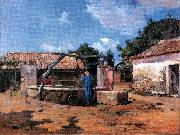 |
Antonio Carvalho de Silva Porto -- Click Here
|
|
(Porto, 11 November 1850 - Porto, 11 June 1893) was a Portuguese naturalist painter.
Born in Porto, he studied there under João Antenio Correia and T. Furtado, then continued his studies in Paris and Rome.
While in Paris he exhibited his work in the Salon and in the World´s Fair of 1878. In Paris, he studied with his friend João Marques de Oliveira, where they were pupils of Adolphe Yvon and Alexandre Cabanel. They became followers of the naturalist Barbizon School, and brought the new school of painting to Portugal, when they returned in 1879.
Silva Porto become one of the most acclaimed naturalist painters of his generation, showing the heritage of Jean-Baptiste Camille Corot and Charles-François Daubigny. Secondary effects from impressionism can sometimes be found in his paintings.
|
|
|
|
|
| | |
|
|
|
|